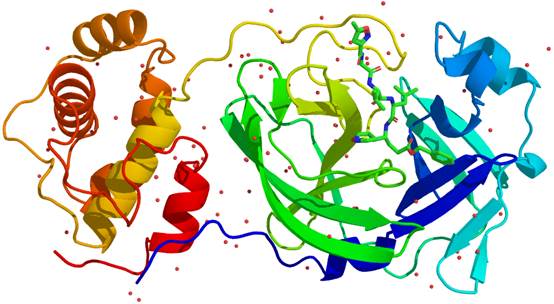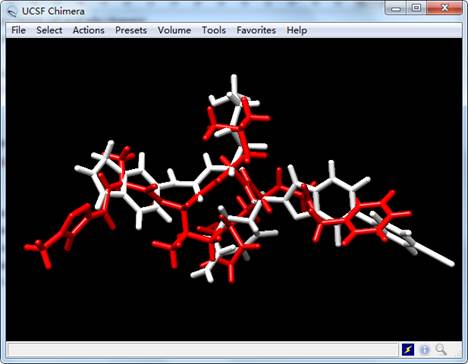1. Introduction
In this tutorial, the SARS-CoV-2 Mpro which leads to the rapid spread of coronavirus disease 2019 (COVID-19) throughout the world is selected as the example target. The vinardo score of ligands is calculated based on the grid file of SARS-CoV-2 Mpro. This example can be generalized to other proteins. Here, MolAICal (https://doi.org/10.1093/bib/bbaa161) is employed for this tutorial.
2. Materials
2.1. Software requirement
1) MolAICal: https://molaical.github.io
2.2. Example files
1) All the necessary tutorial files are downloaded from:
https://github.com/MolAICal/tutorials/tree/master/008-vinardoScore
For more detailed procedures, please go to https://molaical.github.io, and click the section named "Tutorials" in the left part of webpage. Once "Tutorials" open, you can freely find pdf file about this tutorial (see Figure 1):
Figure 1
You can repeat this tutorial according to the content of pdf file.
Showing posts with label SARS-CoV-2 main protease. Show all posts
Showing posts with label SARS-CoV-2 main protease. Show all posts
Tuesday, June 30, 2020
MM/GBSA tutorial by NAMD and MolAICal
1. Introduction
In this tutorial, the MolAICal (https://doi.org/10.1093/bib/bbaa161) is used to calculate the MM/GBSA between ligand N3 and SARS-CoV-2 Mpro based on molecular dynamical (MD) simulated results by NAMD. This tutorial is just a demo. To save running and storage space, only 25 frames of MD simulated trajectories of SARS-CoV-2 Mpro in complex with N3 are selected for this tutorial.
2. Materials
2.1. Software requirement
1) MolAICal : https://molaical.github.io
2) NAMD: https://www.ks.uiuc.edu/Research/namd/
2.2. Example files
1) All the necessary tutorial files are downloaded from:
https://github.com/MolAICal/tutorials/tree/master/004-MMGBSA
For more detailed procedures, please go to https://molaical.github.io, and click the section named "Tutorials" in the left part of webpage. Once "Tutorials" open, you can freely find pdf file about this tutorial (see Figure 1):
Figure 1
You can repeat this tutorial according to the content of pdf file.
In this tutorial, the MolAICal (https://doi.org/10.1093/bib/bbaa161) is used to calculate the MM/GBSA between ligand N3 and SARS-CoV-2 Mpro based on molecular dynamical (MD) simulated results by NAMD. This tutorial is just a demo. To save running and storage space, only 25 frames of MD simulated trajectories of SARS-CoV-2 Mpro in complex with N3 are selected for this tutorial.
2. Materials
2.1. Software requirement
1) MolAICal : https://molaical.github.io
2) NAMD: https://www.ks.uiuc.edu/Research/namd/
2.2. Example files
1) All the necessary tutorial files are downloaded from:
https://github.com/MolAICal/tutorials/tree/master/004-MMGBSA
For more detailed procedures, please go to https://molaical.github.io, and click the section named "Tutorials" in the left part of webpage. Once "Tutorials" open, you can freely find pdf file about this tutorial (see Figure 1):
Figure 1
You can repeat this tutorial according to the content of pdf file.
Two steps for virtual screening in the pocket of SARS-CoV-2 Mpro
1. Introduction
In this tutorial, we introduce the fast way for drug virtual screening of SARS-CoV-2 Mpro based on the known database such as ZINC database. The premise for this tutorial is that you can deal with protein structure for Autodock Vina. If you are not familiar with it, you can learn from the previous tutorial https://github.com/MolAICal/documents/tree/master/tutorials/002-AIVS. Here, MolAICal (https://doi.org/10.1093/bib/bbaa161) is employed for this tutorial.
2. Materials
2.1. Software requirement
1) MolAICal: https://molaical.github.io
2.2. Example files
1) All the necessary tutorial files are downloaded from:
https://github.com/MolAICal/tutorials/tree/master/003-VS
2) The file named “ligandSet.mol2” which contains 16 ligands obtained from ZINC database is chosen for demo. You can select your ligand database.
3) The protein file named “pro.pdbqt” that is PDBQT format structure of SARS-CoV-2 Mpro is used for molecular docking.
For more detailed procedures, please go to https://molaical.github.io, and click the section named "Tutorials" in the left part of webpage. Once "Tutorials" open, you can freely find pdf file about this tutorial (see Figure 1):
Figure 1
You can repeat this tutorial according to the content of pdf file.
In this tutorial, we introduce the fast way for drug virtual screening of SARS-CoV-2 Mpro based on the known database such as ZINC database. The premise for this tutorial is that you can deal with protein structure for Autodock Vina. If you are not familiar with it, you can learn from the previous tutorial https://github.com/MolAICal/documents/tree/master/tutorials/002-AIVS. Here, MolAICal (https://doi.org/10.1093/bib/bbaa161) is employed for this tutorial.
2. Materials
2.1. Software requirement
1) MolAICal: https://molaical.github.io
2.2. Example files
1) All the necessary tutorial files are downloaded from:
https://github.com/MolAICal/tutorials/tree/master/003-VS
2) The file named “ligandSet.mol2” which contains 16 ligands obtained from ZINC database is chosen for demo. You can select your ligand database.
3) The protein file named “pro.pdbqt” that is PDBQT format structure of SARS-CoV-2 Mpro is used for molecular docking.
For more detailed procedures, please go to https://molaical.github.io, and click the section named "Tutorials" in the left part of webpage. Once "Tutorials" open, you can freely find pdf file about this tutorial (see Figure 1):
Figure 1
You can repeat this tutorial according to the content of pdf file.
Tutorials of 3D drug design by AI and virtual screening method
1. Introduction
A new drug development may cost about 2.6 billion USD. However, about 90% of drugs are failure in the process of clinical trial and approval for marketing even though a lot of capital is used to drug development1. In this tutorial, the standard protocol of MolAICal (https://doi.org/10.1093/bib/bbaa161) is introduced for the drug design of SARS-CoV-2 Mpro by artificial intelligence and molecular docking method. It will help the pharmacologist, chemists and other scientists design rational drugs according to the three-dimensional active pocket of proteins.
2. Materials
2.1. Software requirement
1) MolAICal (win64 or linux64): https://molaical.github.io
2) UCSF Chimera: https://www.cgl.ucsf.edu/chimera/
3) MGLTools: https://ccsb.scripps.edu/mgltools/downloads/
4) Python: https://www.python.org/
5) Pymol: http://www.lfd.uci.edu/~gohlke/pythonlibs
It is easily to install the first four software. They can be easily installed by following step tips. For pymol install, it needs modules numpy, pmw, pymol_launcher and pymol. The numpy, pmw, pymol_launcher and pymol should choose the same version and correspond to your installed version of Python in your operating system. They can be downloaded from the below website:
https://www.lfd.uci.edu/~gohlke/pythonlibs/#numpy
https://www.lfd.uci.edu/~gohlke/pythonlibs/#pymol-open-source
Then install Pymol by following command:
#> pip install --no-index --find-links="%CD%" pymol_launcher
The Pymol named “pymol.exe” will be installed in the directory “Scripts” in your installed directory of Python. You can make a shortcut on your desktop of operating system.
Make sure all software is installed rightly.
2.2. Example files
All the necessary tutorial files are downloaded from:
https://github.com/MolAICal/tutorials/tree/master/002-AIVS
For more detailed procedures, please go to https://molaical.github.io, and click the section named "Tutorials" in the left part of webpage. Once "Tutorials" open, you can freely find pdf file about this tutorial (see Figure 1):
Figure 1
You can repeat this tutorial according to the content of pdf file.
A new drug development may cost about 2.6 billion USD. However, about 90% of drugs are failure in the process of clinical trial and approval for marketing even though a lot of capital is used to drug development1. In this tutorial, the standard protocol of MolAICal (https://doi.org/10.1093/bib/bbaa161) is introduced for the drug design of SARS-CoV-2 Mpro by artificial intelligence and molecular docking method. It will help the pharmacologist, chemists and other scientists design rational drugs according to the three-dimensional active pocket of proteins.
2. Materials
2.1. Software requirement
1) MolAICal (win64 or linux64): https://molaical.github.io
2) UCSF Chimera: https://www.cgl.ucsf.edu/chimera/
3) MGLTools: https://ccsb.scripps.edu/mgltools/downloads/
4) Python: https://www.python.org/
5) Pymol: http://www.lfd.uci.edu/~gohlke/pythonlibs
It is easily to install the first four software. They can be easily installed by following step tips. For pymol install, it needs modules numpy, pmw, pymol_launcher and pymol. The numpy, pmw, pymol_launcher and pymol should choose the same version and correspond to your installed version of Python in your operating system. They can be downloaded from the below website:
https://www.lfd.uci.edu/~gohlke/pythonlibs/#numpy
https://www.lfd.uci.edu/~gohlke/pythonlibs/#pymol-open-source
Then install Pymol by following command:
#> pip install --no-index --find-links="%CD%" pymol_launcher
The Pymol named “pymol.exe” will be installed in the directory “Scripts” in your installed directory of Python. You can make a shortcut on your desktop of operating system.
Make sure all software is installed rightly.
2.2. Example files
All the necessary tutorial files are downloaded from:
https://github.com/MolAICal/tutorials/tree/master/002-AIVS
For more detailed procedures, please go to https://molaical.github.io, and click the section named "Tutorials" in the left part of webpage. Once "Tutorials" open, you can freely find pdf file about this tutorial (see Figure 1):
Figure 1
You can repeat this tutorial according to the content of pdf file.
Quick start for de novo drug design of COVID-19 Mpro by MolAICal
Introduction
SARS-CoV-2 caused the rapid spread of coronavirus disease 2019 (COVID-19) throughout the world. In this tutorial, the SARS-CoV-2 main protease (Mpro) which plays an important role on the replication of coronavirus is selected as the example target. The crystal structures of SARS-CoV-2 Mpro have been reported (PDB ID: 6LU7, 6Y2F, etc) [1,2]. Here, the built structure of SARS-CoV-2 Mpro provided by the group of Prof. Zihe Rao is selected as our quick start example (see Figure 1). Here, MolAICal (https://doi.org/10.1093/bib/bbaa161) is employed for this tutorial.

Figure 1. The structure of SARS-CoV-2 Mpro

Figure 1. The structure of SARS-CoV-2 Mpro
Materials
1. Software requirement
1) MolAICal: https://molaical.github.io
2) UCSF Chimera: https://www.cgl.ucsf.edu/chimera/
Make sure every software is installed rightly.
1) MolAICal: https://molaical.github.io
2) UCSF Chimera: https://www.cgl.ucsf.edu/chimera/
Make sure every software is installed rightly.
2. Example files
All the necessary tutorial files are downloaded from: QuickStart
All the necessary tutorial files are downloaded from: QuickStart
Procedure
1. Open “InputParFile.dat” file, it needs to modify four parameters for this tutorial:
------------------------------------------------------------------------------------------
receptorPDB mproNolig.pdb
startFragFile startFrag.mol2
centerPoints -10.733 12.416 68.829
boxLengthXYZ 30.0 30.0 30.0
-------------------------------------------------------------------------------------------
The “receptorPDB” is set to the PDB format structure of SARS-CoV-2 Mpro without ligand. The “startFragFile” is set to the initial fragment. The “centerPoints” and “boxLengthXYZ” represent the box center and length, respectively.
------------------------------------------------------------------------------------------
receptorPDB mproNolig.pdb
startFragFile startFrag.mol2
centerPoints -10.733 12.416 68.829
boxLengthXYZ 30.0 30.0 30.0
-------------------------------------------------------------------------------------------
The “receptorPDB” is set to the PDB format structure of SARS-CoV-2 Mpro without ligand. The “startFragFile” is set to the initial fragment. The “centerPoints” and “boxLengthXYZ” represent the box center and length, respectively.
2. Download and open tutorial folder “000-quickStart”, then run command as below:
#> molaical.exe -denovo grow -i InputParFile.dat
Results
The results are stored in the folder named “001-AIGrow/results”. The “AstatisticsFile.dat” records the information of designed ligands that contain ID, Name, Cluster, Affinity, Formula, InChIKey. The results are just a simple demo example that does not contain complete running results. The complete results can be obtained by finishing this task.
Open crystal ligand N3 named “ligand.mol2” of SARS-CoV-2 Mpro and generated ligand named “lig_11.mol2” (see Figure 2):

Figure 2. The results of generated ligand (white) and inhibitor N3 (red) of SARS-CoV-2 Mpro.
Open crystal ligand N3 named “ligand.mol2” of SARS-CoV-2 Mpro and generated ligand named “lig_11.mol2” (see Figure 2):

Figure 2. The results of generated ligand (white) and inhibitor N3 (red) of SARS-CoV-2 Mpro.
The detailed tutorial can be referred in the first tutorial of “1. Drug design tutorials of MolAICal” in https://molaical.github.io/
References
[1] Jin, Z. et al. Structure of Mpro from COVID-19 virus and discovery of its inhibitors. Nature (2020).
[2] Zhang, L. et al. Crystal structure of SARS-CoV-2 main protease provides a basis for design of improved alpha-ketoamide inhibitors. Science (2020).
[2] Zhang, L. et al. Crystal structure of SARS-CoV-2 main protease provides a basis for design of improved alpha-ketoamide inhibitors. Science (2020).
Subscribe to:
Posts (Atom)



